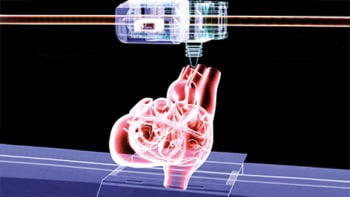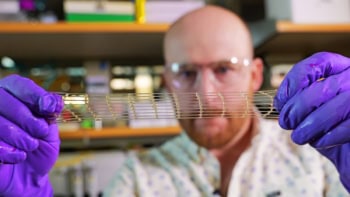Dong-Woo Cho, director of the Intelligent Manufacturing Systems Lab at the Pohang University of Science and Technology (POSTECH) in Korea, is working together with his colleagues to apply mechanical engineering know-how to biofabrication. Potential applications for the team’s work include the repair of complex bone and cartilage injuries, as well as non-transplant based treatments for end-stage liver disease.
Cho has long been interested in the use of 3D printing technology to fabricate micro-sized structures, and in the early 2000s he chose to make the jump into biofabrication. “We had the chance to discuss our research with medical doctors and there was a hint that microstructures could have a dramatic impact on cell activity,” he recalls. “That motivated us to work with biocompatible materials.”

The group’s core expertise is 3D printing-related manufacturing technology, which involves system design as well as the development of printing processes and software technology. But that’s only part of the picture. “Collaboration with experts in the field of biology and medicine is essential for the application of biofabrication,” Cho comments. “Research on this topic becomes more meaningful when cellular and clinical expertise is reflected in the work.”
Over the last 15 years, the group has been proactive in building networks domestically and internationally to link its mechanical engineering expertise with biologists and physicians. Cho is excited by prospects for the technology, such as the potential of 3D bioprinting technology to boost patient-specific medical care.
“Traditional medical practice typically relies on products manufactured with a mass production paradigm,” he explains. “However, by using 3D bioprinting technology, we have the opportunity to personalize not only the outer shape of a device, but also its inner structure.”
Taking tissue scaffolds as an example, 3D printing could produce structures that are a much better fit for patients and could also enable cells to be printed at the histologically desired location for organ regeneration.
Recently, Cho and his team highlighted this benefit by examining the regeneration of tissue in rabbit knee joints. In the work — published in the journal Biofabrication – scaffolds that had been tuned to match cartilage and bone regions were able to smoothly regenerate tissue in as little as eight weeks. “As a follow-up study, we will investigate localizing not only the extracellular matrix, but also tissue-specific cells at the desired location,” Cho adds.
Applying this tailored approach towards the repair of organs such as the liver, the team has also shown that bioprinting can be used to establish and maintain a co-cultured 3D environment of multiple types of cells. “In order to regenerate liver tissue, it is very important to realize the hepatic histological structure as it is,” Cho points out. “In other words, you need to promote the growth of hepatocytes and hepatocyte surrounding cells, as well as blood vessels.”
Adding to the challenge is the need to realize a solution in three-dimensions to better match the performance of the native micro-environment, since the regeneration will then be more efficient.
Building-up structures layer-by-layer also allows researchers to introduce porosity where needed to encourage vascularization deep inside the biocompatible construct – which in turn will help to enhance tissue formation. Indeed, Cho’s team has already used 3D patterning-enabled porosity to good effect in studies on bone repair and on liver regeneration.
Another design feature being investigated in the lab is how to optimize the scaffold’s strength so that its form persists during treatment. In earlier work, the team integrated a mechanically stiff polymer (polycaprolactone) as a framework material, but it hopes to simplify the design for clinical applications.
Ideally, the researchers would prefer to 3D-print their constructs using bioink that’s able to maintain its shape without the support of an additional framework. Suitable materials are now being evaluated by Cho and his group as they work towards their goals in 2018.
- Read our special collection “Frontiers in biofabrication” to learn more about the latest advances in tissue engineering. This article is one of a series of reports highlighting high-impact research published in the IOP Publishing journal Biofabrication.



